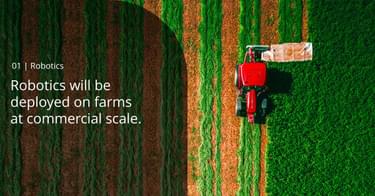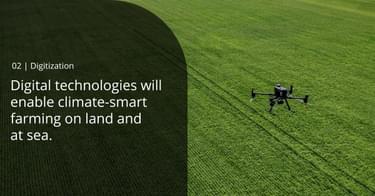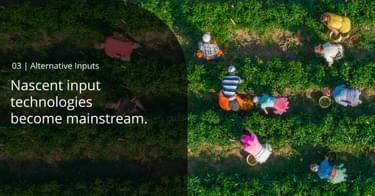
Reflections on 2023 AgTech Trends



This is the first installment of a series looking back on our report, “Trends Shaping the Future of Food in 2023.” Read Part 2 of this series, “Reflections on 2023 Food and Agriculture Supply Chain Trends,” and Part 3, “Reflections on 2023 Food Tech Trends.”
“2023 was a tough year for startups. It was the warmest year on record, and emissions from fossil fuels hit a new high. Geopolitical turmoil, inflation, rising interest rates, hesitant corporate customers, continued supply chain disruptions, and shrinking sources of capital created a challenging environment for private markets. Global startup funding plummeted to $285 billion, down 38 percent from 2022, according to Crunchbase. Climate tech investment saw a 30 percent year-on-year drop in 2023, according to a report from Sightline Climate, which means despite the decline, the sector still outperformed other sectors, with its share of venture capital and private equity investment growing to 10 percent, up from 7 percent in 2018.
Companies have had to focus on stretching existing funding and drastically reducing their burn to show how they might be profitable. But constraints, while uncomfortable, are great for entrepreneurs. The increasing cost of capital meant companies needed to find creative ways to build their businesses. Downturns tend to help entrepreneurs prioritize investment and, ultimately, spending.
There were other promising signs of growth: first-time funders joined deals in large numbers; new technologies that can address climate change, from heat pumps to EVs, are coming to the market and becoming more affordable for consumers; climate policies, from incentives to rules around pollution, are getting passed; and the IEA projected that 2023 would see $1.7 trillion go toward deploying renewables, grids, and other clean-energy technologies.
In March of 2023, we published a white paper entitled “Trends Shaping the Future of Food in 2023.” Almost a year later, we explore the year’s events that influenced the evolution of each trend and our view on its momentum going into the new year. In this post, we will explore how the trends around farmers scaling climate-smart agricultural practices fared in 2023.

) In 2023, we said, “Agriculture autonomy is no longer a science project. Several companies are booking revenues in excess of seven figures and developing into viable businesses with real commercial use cases.”
In 2023, we said, “Agriculture autonomy is no longer a science project. Several companies are booking revenues in excess of seven figures and developing into viable businesses with real commercial use cases.”
Agricultural workforce shortages and growing demand for (higher touch) sustainably grown products are still major driving factors in the adoption of ag robotics. While some companies are delivering on booked revenue, progress has not been ubiquitous across the field. Also, while some companies have now deployed hundreds of robots in the field, none have reached thousands yet. Autonomous weeding has seen the most commercial advancement and subsequently attracted the most funding. Companies like Carbon Robotics, which raised $30 million in Series C funding this year, as well as Ecorobotix, which raised $52 million, are leading the charge.
However, there are a number of indications of the growing popularity of on-farm automation. FIRA USA, an annual event focused on ag robotics, welcomed more than 1,700 participants from 40 US states and 30-plus countries this year, doubling its attendance. Growers are starting to hire dedicated personnel to deploy and maintain automation and agtech solutions. This also means there is an urgent need to build up that talent pool of people who can operate and problem-solve those machines.
One of the biggest knocks on the industry has been the focus on point solutions. However, companies are beginning to partner to offer platform solutions. Companies working on the mobility side, like Farm-ng or S2G portfolio company Burro, are partnering with companies offering other capabilities, such as scouting or pollinating, to provide more value to the farmer. Companies that are focusing on an “infrastructure play” to bring autonomy to basic tasks like navigation and non-dexterous implement manipulation will be critical for the whole ecosystem. These companies are also seeing funding, such as Burro’s $24 million Series B, Agtonomy’s $23 million Series A, and Farm-ng’s $10 million Series A.
Another meaningful development is that automation companies are partnering with ag rental dealers to offer software-as-a-service options. For example, Burro announced a partnership with Pacific Ag Rentals, a leading provider of agricultural tractor and equipment rentals in the US, which will add Burro robots to PAR’s equipment pool. Leasing models can serve as a powerful driver of adoption because they help unlock the benefits of ag robotics for smaller farms without the upfront cost.
In terms of scaling these solutions, ag can learn from other parts of the value chain where robotics have reached greater commercialization. For example, indoor warehousing robotics has seen broader-scale adoption and bigger exits. And companies like S2G portfolio company IUNU, which is developing an AI-driven platform enabling indoor growers to capture data and manage processes, have moved from validation to building infrastructure to scale their offerings. These are easier problems to solve than deploying robots in the field, but they create a good blueprint for how automation companies have built their contracts and added value right away for their customers.

In 2023 we said, “Measurement and analytical tools are becoming more integrated and better equipped to quantify the cross-value chain benefits of climate-smart agriculture. As digital technologies scale to more farms, they will provide new insights and opportunities to optimize environmental and economic outcomes for all stakeholders, from farmers to CPG companies.”
The backdrop for digital ag has been tough, with concerns of unclear value propositions, high costs, and a saturated market, making it challenging for farmers to discern the right solutions for their needs. Despite the overall rocky fundraising environment, over the past year, we have seen an uptick in the deployment of digital technologies in agriculture. According to estimates from Deloitte, the installed base of IoT endpoints for precision crop farming, livestock management, and agricultural equipment tracking rose to 241 million units, up from 198 million in 2022. Precision agriculture has moved beyond being just a buzzword and is now integral to everything from product development to marketing.
Companies gaining traction are not only building innovative products but also have solid business models and go-to-market strategies, and we are seeing success with solutions that have clear value propositions, such as precision agriculture technologies. For example, Trace Genomics, an S2G portfolio company that provides farmers with comprehensive and precise soil insights, and CHS, a leading US agribusiness, expanded their relationship to increase the number of CHS growers and geographies that have access to Trace’s technology. Trace is writing the rules on how we understand soil, and the payoff for farmers is substantial. On the aquaculture side, eFishery, an Indonesia-based digital feed, financing, and offtake platform, became the first aqua-tech start-up to reach unicorn status when it surpassed a $1 billion valuation in July.
We believe the scalability of these technologies is also on a good path. EarthOptics’ soil data measurement and mapping solution is now being used on 1 million acres, a significant step forward in providing farmers with carbon and NPK measurement data in a cheaper and more scalable way. Partnerships between companies with data collection platforms as well as technologies like Leaf’s unified API for food and agriculture are helping to remove data silos and provide more precise and actionable insights for farmers.
There is also growing interest from CPGs in precision ag and data collection technologies. For example, leading food companies, such as Bayer and Danone, formed the First Movers Coalition at COP and announced a combined procurement commitment with an estimated value of $10-$20 billion for sustainably produced and low-emission agricultural commodities by 2030.

In 2023, we said, “The need is as critical as ever to fill the vacuum for environmentally friendly, effective inputs. We believe the time is now for alternative input solutions to achieve large-scale adoption and impact.”
As we move further into 2024, the need is still as critical as ever for environmentally friendly, effective agriculture inputs, but some key drivers have shifted. For example, chemical input prices have fallen, in some cases, as much as 30 percent from historical highs a year ago. But in an increasingly volatile world, we believe prices and supply will remain variable. We also expect demand for environmentally responsible inputs to grow due to consumer preferences and scope 3 commitments, especially as organic and regenerative products can be more affordably produced.
We are seeing growth in customer adoption. For example, S2G portfolio company New Leaf Symbiotics, which produces a pink-pigmented facultative methylotrophs solution that makes plants more resilient and better able to absorb other inputs, is seeing significant repeat and sizable purchases. There has also been exciting progress in regulation. S2G portfolio company GreenLight Biosciences, just received the “first ever” EPA approval for an RNA foliar applied pest control for their Colorado Potato Beetle solution called Calantha. It is a product that has a known mode of action, is as effective as available solutions, and is surgically precise with no off-target impacts. Additionally, in making this approval, the EPA has created a group within the organization for a new pathway for RNA-based interventions, meaning the EPA is hoping other products can be approved through this pathway.
In terms of these nascent technologies becoming mainstream, much of the change we hope to see will take more than a year to develop. Ultimately, it is incumbent upon companies to prove efficacy, which is inherently a laborious process. Farmers need to know that these products won’t just have reduced off-target impact but work year after year on particular types of soil or for specific crops. For most crops, this requires many years of trials. But as more data becomes available, these critical purchasing decisions will become much easier for farmers.
In 2023, farmers continued to embrace precision agriculture technologies, especially if they offer clear ROI. In our opinion, the case is strong for technologies that can help farmers meet environmental regulations and consumer and CPG demand for sustainably grown products while improving the farmers’ bottom line. As data-backed solutions continue to emerge along with partnerships that can provide more value for farmers and make these tools more accessible, we believe the adoption of these technologies will continue to accelerate.
Stay tuned for our reflections on 2023 food and agriculture supply chain trends.
Listen to more insights about the food and ag sector in the S2G Podcast.




